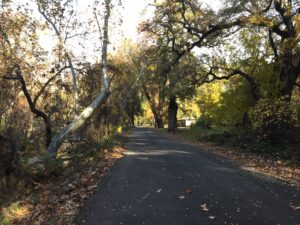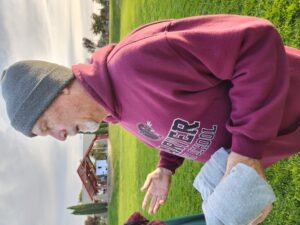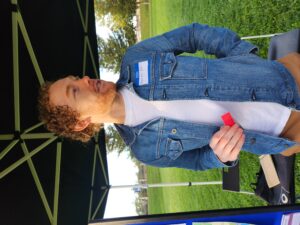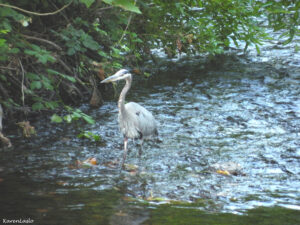by Natalie Hanson
posted Nov. 1
The city of Chico winds around one of the largest municipal parks in the country — Bidwell Park. Step off the sidewalk and enter the park, and the city seems to disappear. You’re under a tree canopy, on a street or trail lined with oaks, ferns and sycamores.

Park lovers -— who on most days see dog-walkers, cyclists, runners and skateboarders -– say they fear losing this precious place to climate change, wildfires, littering and human overuse and indifference. Residents and scientists say they want to see city leaders step up to protect the parks to prevent loss to wildfire and climate change -– particularly now that usage has increased. Bidwell, like many of California’s public parks, saw an increase in visitors during the COVID pandemic.
Bidwell Park — which the city boasts is its “crown jewel” — is among the 40 largest municipal parks in the country, but is still only slightly more than half of the city’s nearly 6,500 acres of open space that is enjoyed in the form of neighborhood parks, greenways and preserves. The debate over how these public spaces should be managed has grown particularly heated amid political battles around homelessness.
Chico’s park and natural resources manager Linda Herman said the city doesn’t have formal counts on park usage, in part because Bidwell Park has so many entry and exit points. But staff believe usage has increased because of a substantial population increase in Chico after the Camp Fire, as well as the increased desire for outdoor gathering spaces during the pandemic.
Encampments of unhoused people in parks and on greenways also grew after the Camp Fire -– and as the problem of homelessness became campaign fodder in local elections. Forced by a settlement to a lawsuit, the city this year added pallet shelters to its emergency sheltering options, a step that has helped reduce and even eliminate some encampments. But advocates for unhoused people insist the city needs to do more, ensuring a larger supply of affordable housing and a sanctioned campground.
And some Chicoans believe the parks need more attention on many levels to stop plants from dying and reduce fire risk.
Across the state, city officials are grappling with the effects of increased use of public parks; those concerns were the topic of a panel discussion last week hosted by Ethnic Media Services (EMS). Panelists said it’s important to strike a balance between the desire to welcome higher numbers of park visitors and the need to take care of the park environment. East Bay Regional Parks District board member Dee Rosario said the influx also reflects an increasing desire to be outdoors and connect with natural surroundings.
Maintenance an issue
The Parks Division in Chico has a $1.77 million budget through 2023, a small increase from the 2019-2020 budget of almost $1.71 million. That’s less than 1% of the city’s $211-million budget. The parks division added a new maintenance worker position this year, but has only five workers in total, with one hourly aide and a Chico State intern. Years ago, there were seven or eight maintenance positions.
Herman said a volunteer program with community partners to help maintain and improve the park has begun “bouncing back” after volunteering slowed during the pandemic.
She said fire prevention is a big part of maintenance, including goat grazing throughout city parks and greenways and cattle grazing on preserves for fire prevention.
“We continue to use the California Conservation Corps and other work forces to help elevate trees and vegetation, and to remove downed wood and invasive plants in the park and greenways,” she said. The parks division is also working with Chico Fire and the Big Chico Creek Ecological Reserve fire crew to use prescribed burning in Upper Park to help reduce fire risk.
The rocky terrain of Upper Park and the open spaces and preserves draw scientists working in wildlife from all over the state.
But resident Beverly Paull said in a letter to the editor to the Chico Enterprise-Record that the Chico City Council needs to better address dead trees and dried underbrush throughout the park that make it “ripe for a fire disaster.”
“With just one lightning strike or one spark from a match or one car backfire or one cigarette butt tossed from a car, our beautiful park and nearby homes would be destroyed by possibly the worst catastrophe to hit Chico,” Paull wrote. “With our changing weather patterns and our disappointing rainy seasons, the work to save our park and city needs to happen now.”

Climate change impacts
The EMS briefing on parks featured East Bay Regional Parks’ Becky Tuden, an environmental services manager who warned that climate impacts like warmer weather and drought continue to stress parks.
“We don’t want them to be consumed, we want them to be meaningful to present and future generations,” she said.
Chico State geography professor Mark Stemen, vice chair of the city’s Climate Action Commission, said a warmer climate is drying out native trees in Chico like the native holly oak. The city’s unique forested ecosystem weaving through urban land requires immediate work to plant more adaptive trees and mitigate fire danger, he said.

Some of the work includes planting new trees that are more climate adaptive and can help cool the city, he said.
“The biggest problem we have with the trees right now is that as the air warms, it can hold more moisture -– so it’s literally pulling the water out of the soil, out of the plants,” he said.
Stemen said organizations like Butte Environmental Council (BEC) are using UC Davis’s list of climate-adaptive trees to start planting varieties. These include the valley oak, which counters impacts of falling water tables with an “extremely deep tap root” and the blue oak, which places nearly all of its roots near the soil surface so it can gather any nearby water.
Butte Environmental Council’s chair Lacey Moore and vice chair Aaron Kunst said they wish the city would put in more effort to protect the parks from changing conditions. Moore said the city needs to do more to prevent losing more trees that are so critical to preserving the local climate.
“The state drought is affecting trees and canopies, and those are important to help keep the community cool and preserve micro climates,” she said.
The future
Kunst said many people are voicing desires for parks within the city as places that should be accessible and usable for many purposes. He argues the city should be considering biodiversity as well as location as it adds parks.

For example, Children’s Park downtown is not located by affordable housing and sees fairly low usage -– and may pose less community benefit than parks that are within walking distance from more widely affordable homes, Kunst said.
Chico’s Ali Meders-Knight, executive director of the land conservancy nonprofit California Open Lands, said she wants city leaders to encourage people to get hands-on in the parks and learn how to take care of them.
“Nobody’s really touching and taking care of the land,” she said. “This has created for the city the idea of an open mouth that always needs to be fed, and ecosystem maintenance becomes a liability because of the cost of labor. The problem is, we equate taking care of the ecosystem of Bidwell Park with money.”
She said the city should seek grant opportunities from the state to encourage hands-on maintenance and conservation -– and as a way to address climate change, committing to the state’s “30×30” initiative to conserve 30% of public land by restoring natural ecosystems.
Herman said the city is always looking for grant funding for park improvements and partners with the university’s Big Chico Creek Ecological Reserve in educational efforts.
Meders-Knight also thinks the political focus on homelessness ends up excluding other issues from discussion, such as damage sometimes caused by park-users with dogs or destructive habits that harm wildlife.

But the focus on homelessness has grown even more intense in recent weeks prior to the Nov. 8 election as a political action committee uses the issue to attack liberal candidates, falsely accusing them of inviting unhoused people from elsewhere to Chico, and suggesting that homeless encampments are contaminating waterways. (Service provider Cal Water released a statement last week saying that “Chico’s drinking water is not compromised.”)
Meders-Knight is also critical of city policies that focus on park policing because, she said, police do not stop falling dead trees, floods or fires.
“The city doesn’t have enough people at City Hall that have the information to move forward making the park something positive,” she said. “It’s been a while since we’ve had [elected] leadership that even understood ecology.”
Meders-Knight, a member of the Mechoopda Tribe, runs a hands-on model at Verbena Fields, holding workshops on indigenous practices that get people outdoors and learning about wildtending and native plants.
“If we could create those kinds of educational areas, especially near low-income areas, I would like to measure the difference it makes,” Meders-Knight said. “I think it’s worth measuring and studying and getting money in because Chico’s a great place to do that.”
Kunst said BEC supported Assembly Bill 379 enabling non-profits, agencies and tribes to take back and manage park lands and preserves in California. As a result of AB 379, 93 acres of Butte Creek Ecological Preserve were recently returned to the Mechoopda.
Like Meders-Knight, BEC has been working to get people on the ground in the parks for years. The council organizes a city-wide cleanup in the parks every year and plants new trees year-round. BEC participated in Climate Action Day on Oct. 29, leading one of the many groups of volunteers in a project to plant new fruit trees on Park Avenue as part of a new South Chico climate resiliency effort.
Natalie Hanson is a contributing writer to ChicoSol.
This story has been corrected to state that Bidwell Park is among the 40 largest municipal parks in the country.

Hi Natalie,
Great article, thank you. Important, though, not to perpetuate the myth that Bidwell Park is the 3rd largest municipal park. Still one of the largest for sure but it ranks 26th. Check out “Since You Asked” on NSPR.
Keep up the good work,
Mary